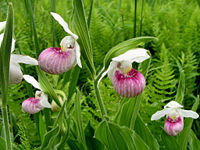Plant (organism)
| Plantae | ||||
|---|---|---|---|---|
 Cypripedium reginae
| ||||
| Scientific classification | ||||
| ||||
| Divisions | ||||
The green plants (from the Latin planta, meaning "sprout") are those organisms classified into the kingdom Plantae. Descending from a single common ancestor, the plants take up a large portion of life—with estimates exceeding 285,000 species—and include many familiar and ubiquitous species including trees, shrubs, cacti, grasses, herbs, ferns, mosses, and green algae. Plants share certain characteristics—unlike animals and fungi, they do not voluntarily move, typically growing in a permanent site, passively absorbing nutrients and energy from their environment. In terms of both their total mass and their importance to other organisms, the green plants dominate ecosystems in both land and freshwater. By harnessing sunlight through photosynthesis, they act as the primary producers of food for all life in those ecosystems: green algae in freshwater and land plants on the land.
Definitions
The term "plant" has gone through several definitions along history. Plants, which do not move, were distinguished from animals, which do move, by Aristotle in his works on metaphysics and logic. Aristotle continued to influence classification of plants all the way to Carl Linnaeus, who divided all life into the two kingdoms Vegetabilia (or Plantae) and Animalia. Fungi and protists were originally grouped into Plantae, but they were moved into their own kingdoms when it became clear that they were very different from plants.
At this time, the algae were reclassified as protists, which included a hodgepodge of many unrelated aquatic organisms that, like land plants, could capture energy from sunlight using photosynthesis but had developed it independently. The many varieties of seaweed, for instance, may resemble land plants but are divided among the green, red, and brown algae.
Most of the algae are still considered separate from the land plants today. The green algae, however, have recently been placed back into the Plantae, as they form a clade with the land plants (meaning the green algae and land plants are descended from one common ancestor).
Characteristics
From the first green algae growing on ancient, muddy shores, the plants were the first organisms that could stay alive completely exposed to the air. As they colonized the land, they diversified into an astonishing array of light-capturing, reproducing machines. Living on land would dry out and kill vulnerable cells, and yet it also offers a windfall of resources and unfiltered sunlight, both which are scare in aquatic environments. Therefore, despite their diversity some themes thus appear within the plants, as a result of having to cope with the unique, common problems of living and reproducing on land. Those early plants with these adaptations were favored by natural selection, and of those plants, those that solved the water problem best tended to live and reproduce more. These similarities described below have made living in dry conditions—even deserts—possible.
Cells
Like the animals, fungi, and protists, plants are eukaryotic—they are composed of cells which contain a cell nucleus encapsulating their DNA. Also, like the cells of the cyanobacteria, red algae, and brown algae, plant cells contain the green chemical chlorophyll to capture sunlight. The chlorophyll is stored inside chloroplasts, organelles adapted for carrying out photosynthesis. Photosynthesis fixes carbon dioxide dissolved in the cell from the air, and uses it to store energy, transforming it into glucose, a food, for later use. This energy is captured from the radiation of the Sun using the chlorophyll, all within the chloroplasts.
Plant cells also always have a cell wall surrounding their cell membranes.
Cuticle and stomata: combating water loss
Plants' outer, aboveground surfaces are surrounded by a skin skin made of sheets of a waxy chemical called cuticle. Cuticle, which appeared very early encasing plant spores, is a watertight sealant without which plants would dry out in air. The development of cuticle was one of the most important innovations that made colonizing land possible.
The impermeability of cuticle for water also makes it more difficult for gases such as carbon dioxide to pass through. Most modern plants solve this with microscopic holes called stomata.
Origin and phylogeny
Despite Phylogeny changing many of the concepts of how plants should be classified and what divisions remain, currently plants are informally divided among four main groups called; green algae, about 8.000 species; non vascular plants, or Bryophytes, circa 20.000 species; the ferns and horsetails, or Pteridophytes, around 12,000; and seed plants, that is the largest group with 260,000 estimated species. These are split in twelve total divisions:
- Chlorophyta: part of green algae
- Charophyta: the rest of green algae
- Marchantiophyta: liverworts
- Anthocerotophyta: hornworts
- Bryophyta: mosses
- Lycopodiophyta: club mosses
- Pteridophyta: ferns
- Cycadophyta: cycads
- Ginkgophyta: ginkgo
- Pinophyta: conifers
- Gnetophyta: gnetophytes
- Magnoliophyta: flowering plants